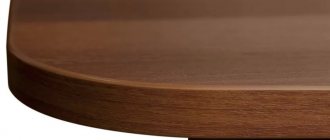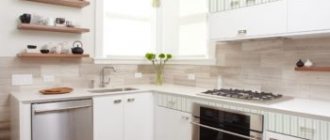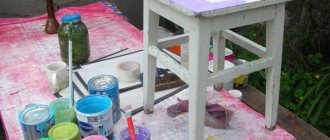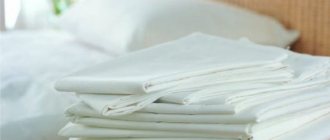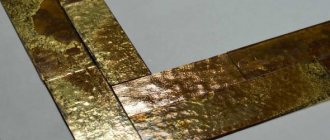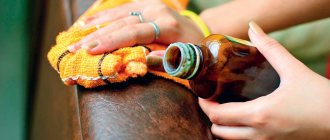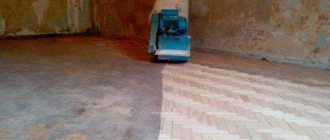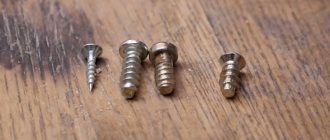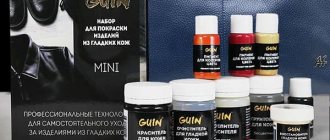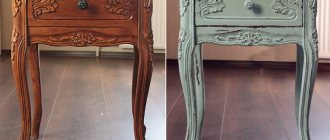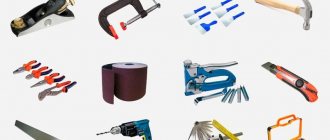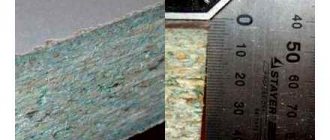Chipboard edge: how to process the ends yourself
After cutting the chipboard with your own hands, you will be faced with the need to process the visible ends of the future product. When compiling a list of parts, seeing the drawing in front of you, it is better to immediately mark the sides that will need to be covered with a special edge in order to hide the bare cut of the chipboard. The edge of chipboard can be different, let's look at the three most common options.
PVC edge is the best option for cladding the ends of chipboard
The term PVC (Polyvinyl chloride) is quite well known; it refers to a thermoplastic that is used in various ways in furniture production and decoration.
PVC furniture edge is a rigid tape of different thicknesses, from 0.5mm to 2mm, with a decorative coating applied in contrast or “to match the color” of the chipboard texture. An edge of this type is very resistant to mechanical damage and perfectly protects the ends of the chipboard from moisture penetration and chipping. But there is one important thing. It is impossible to glue a PVC edge to the end at home, without special tools, glue and skill.
Therefore, an excellent option would be to order edging of PVC parts immediately after cutting. The cost of the thinnest PVC tape with a thickness of 0.5 mm is almost equivalent to melamine tape (excluding gluing work). And the type of furniture and its durability characteristics will increase significantly. In addition, on visible ends (countertops, open shelves, facades) a PVC edge with a thickness of 1-2mm looks much more solid and beautiful. Don't forget to take its thickness into account when calculating the dimensions of the parts!
Wraparound overlay profile - an option for hiding chips and unevenness
If you purchased ready-made Leroy furniture panels or sawed chipboard yourself with a jigsaw, then most likely the quality of the cut is not very good. You can probably see chips along the edge, and the cut itself is not entirely even along the length, with a blocked horizon. If the parts are used to assemble a dressing room or wardrobe and the design itself is a combination of shelves and standing ones, then to hide the flaws you can use the so-called “hammered” edging (profile).
The wraparound overlay profile is a rigid or flexible U-shaped edging made of plastic or PVC, which fits tightly onto the edge of the chipboard.
With its edges, such an edging extends onto the front sides of the chipboard, enveloping it to a depth of 2-3mm. Thus, all chips and unevenness of the end become invisible.
Before “putting on” the U-shaped PVC profile, it is advisable to treat the ends of the chipboard with sealant and apply glue in spots for fastening strength.
Don't forget to take into account the thickness of the overlay edging when calculating! For example, in shelving structures it is better to deepen the shelves by 5 mm relative to the vertical sides.
The disadvantage of this option is that it is not suitable for processing the ends of facades, drawers and other elements.
Melamine chipboard edge: how to glue it with an iron at home
Melamine (or, as they also say, paper) edge for chipboard is a tape with a decorative coating on one side and glue on the other.
The process of gluing it to the end of a chipboard at home is extremely simple and understandable:
- We install the chipboard part vertically, with the processed end facing up.
- We apply the melamine edge evenly to it.
- Gently run the heated iron several times.
- After gluing, wait until it cools down and cut off the excess with a stationery or shoe knife.
- After cutting the edges, additionally sand with fine sandpaper.
It is better to first determine the optimal heating temperature of the iron experimentally, on a small piece of tape. If the temperature is insufficient, the glue will not melt completely; if it is too high, it will be “absorbed” into the chipboard, and the tape will also not stick well. You need to be careful with the selection of temperature and with dark melamine edges (wenge, black) - whitish spots may appear on the surface.
To make it easier to hold the chipboard workpiece in a vertical state, you can use clamps or construct a kind of “groove” from scraps into which the part can be inserted and fixed.
That's all the tricks for independently processing the ends of chipboard and gluing with melamine tape at home.
Source: delay-shkaf.ru
cover the bare end of the chipboard - with what?
I assemble modular furniture, not expensive. There are a lot of “bare”, uncoated chipboard ends (invisible edges of shelves, bottom edges of walls, etc.). What could be so simple to cover them with so that the phenolic muck doesn’t evaporate from them? Nothing comes to mind.
Paint. (it turns out to be a collective farm)
What fumes? What phenol?! How did we still survive in such a time?! Coat the ends with PVA glue, twice, rubbing the glue into the cut, with intermediate drying, and the air in the apartment becomes cleaner and easier to breathe.
Shikhael Muma wrote: How to cover them up with something so simple
The cheapest is melamine edge, you can glue it yourself at home.
if the edge does not fit, then use silicone or impregnate with wax
What's the point of reducing the area? anything, even plasticine, PVA, putty (better than acrylic), paint, even toothpaste... as long as it lasts. I varnished the ends in the kitchen 4 times, with intermediate drying, just to protect them from moisture..
Well, it’s probably better to paint it thicker than thread. Paint is not a problem, with a brush, just like that.
Shikhael Muma wrote: I am collecting modular furniture, not expensive. There are a lot of “bare”, uncoated chipboard ends (invisible edges of shelves, bottom edges of walls, etc.). What could be so simple to cover them with so that the phenolic muck doesn’t evaporate from them? Nothing comes to mind.
Stick the melamine edge
Nina EA wrote: Glue the melamine edge
How realistic is it to use an iron on your knee at home?
I tried to rub the end of the chipboard with a candle, and then use a hairdryer - the paraffin was absorbed like water. Simply and easily. I'm wondering if once is enough.
Shikhael Muma wrote: How realistic is it to use an iron on your knee at home?
Exactly at home and with an iron or just glue. Note the melamine edge and not the PVC edge. Or just veneer + PVA + iron + sandpaper + varnish
Nina EA wrote: Please note the melamine edge
Please note, beauty is not needed, no one will see. How do you like paraffin?
Nina EA wrote: melamine edge, not PVC edge.
The edges, although slightly, will distort the size of the chipboard. The connection may be disrupted.
Shikhael Muma wrote: How do you like the paraffin?
Are you sure there won’t be any gas leaking through it? Is it harder to cover the ends with paint?
iale wrote: are you sure that there will be no gas through it?
iale wrote: Is it harder to cover the ends with paint?
easier, but longer. Are you sure that there will be no gas leaking through it?
Shikhael Muma wrote: Are you sure that there will be no gas leaking through it?
Not 100%, but after coating the ends of the chipboard with alkyd Pesto in the new cabinet, the smell of “chemicals” became much weaker. It’s hard to say what the contribution of F-F is, there was no GA at hand
Shikhael Muma wrote: How do you like the paraffin?
Grouting with paraffin is an option, cheaper waxing, and as we know, nothing better than wax has yet been invented.
iale wrote: The edges, although a little, will distort the size of the chipboard. The connection may be disrupted.
+5 Two layers of edge, that's + 1.5 mm
Ded_Mazay wrote: either silicone or impregnated with wax
+5 I wouldn’t bother with paraffin, but would apply and rub in silicone sealant.
If required, the chipboard surfaces adjacent to the walls may not be treated with anything at all. Well, if you have the urge, then the varnish is water-based - it dries quickly and does not smell much.
WEREG wrote: I wouldn't bother with paraffin, but would apply and rub in silicone sealant.
The paraffin melted under the hairdryer and was instantly absorbed into the sawdust. And now the end feels paraffin. What about the sealant in terms of rubability and adhesion to chipboard - won’t the film come off?
Uncle Syoma wrote: the chipboard surfaces that are adjacent to the walls need not be treated with anything at all.
And the lower edges are the floors.
Uncle Syoma wrote: the varnish is water-based - it dries quickly and doesn’t smell much.
And the end of the chipboard is saturated with water
Shikhael Muma wrote: What about the sealant in terms of rub-in and adhesion to the chipboard - won’t the film come off?
Shikhael Muma wrote: And the lower edges are the floors.
And the lower ones - just like I was impatient - with water-based acrylate varnish.
Danuna, is the experiment going to boom?
Can you imagine what water-based acrylate varnish turns into after polymerization? And those 5 grams of water that may penetrate into the chipboard will not make any difference.
Shikhael Muma wrote: invisible edges of shelves, bottom edges of walls, etc.).
Uncle Syoma° wrote: According to the requirements, the chipboard surfaces that are adjacent to the walls can not be treated with anything at all. Well, if you have the urge, then the varnish is water-based - it dries quickly and does not smell much.
I puttyed and sanded under the varnish, the end turned out to be what I needed
Shikhael Muma wrote: Please note, beauty is not needed, no one will see. How do you like paraffin?
I melt the open ends with hot melt glue and take the remnants from the glue sticks to the hot-melt gun. I crumble, put glue crumbs on the end of the chipboard and melt them with an ordinary electric soldering iron, and level them with the side surface of the tip and pass through.
The surface is smooth, flush with the edges. The glue squeezed out onto the edges can be easily cut off with an “office” knife with a retractable blade.
WEREG wrote: Danuna, is the experiment going to boom?
It’s a matter of business You can even “stir up” a whole study - brand, type of sealant, national, imp. Chipboard, type of glue that binds chipboard, density and strength of chipboard, surface roughness, etc.
Uncle Syoma° wrote: Can you imagine what water-based acrylate varnish turns into after polymerization?
I imagine there are different types of water-based varnish, often in the form of a thick emulsion, for which deep penetration is possible in the case of strong dilution with water to a consistency a la Celco Sauna, respectively, the dry residue there will hardly be more than 20%.
Why is lamination needed?
Cheap and fairly durable chipboard is the most popular material for the manufacture of inexpensive furniture. In their natural form, pressed slabs made from shavings and sawdust do not look very decorative, so manufacturers finish their surface and edges with films of plastic or paper impregnated with synthetic resins. Lamination involves the process of pressing and gluing films onto a board.
The coating not only makes the material more decorative. Laminated chipboard is characterized by higher moisture resistance compared to the original material. This makes it possible to use laminated chipboard for the manufacture of kitchen units and other cabinet furniture that has to come into contact with a humid environment.
We use self-adhesive film
Self-adhesive film will help quickly renew shabby tables and worn-out kitchen units made of chipboard. The variety of textures and colors of the material will allow you to create a new style of furniture and fit it into the modern interior of your home.
For work you need to prepare: self-adhesive film, knife, soft rag.
Algorithm of actions:
- furniture unwinds into its component parts;
- surfaces are thoroughly cleaned and degreased.
- Secret: water with the addition of liquid dishwashing detergent will help clean surfaces. A solution with vinegar will help degrease furniture;
- the prepared surfaces are covered with self-adhesive film.
- Important: film cutting is carried out taking into account 10 mm allowances. Before pasting, the furniture is lightly moistened with water from a spray bottle. This will help you easily correct folds and distortions during operation;
- The pasted surfaces are smoothed with a soft cloth. If a bubble remains under the film, puncturing it with a needle will help remove it.
Which film to choose for lamination?
In factory conditions, chipboard lamination is carried out using:
- laminated paper impregnated with resins;
- impregnated papers made from similar materials.
When using resin impregnation, the paper can be given moisture-repellent properties, and a thick layer of material allows for embossing that imitates the texture of valuable wood or stone.
Both natural veneer and thermoplastic synthetic films are used as coating. In each case, the chipboard processing technology is slightly different, but in everyday life all materials with a moisture-resistant coating are called laminated.
When choosing ready-made slabs for making furniture, you should inquire about the gluing method:
- laminated chipboard does not differ in appearance from laminate, but has less coating strength;
- veneered products always have a natural wood pattern; you can consider individual coating plates;
- covered with synthetic veneer (film) differ from natural ones in their low price and the absence of strips of wooden cladding in the design.
Often, when making furniture on their own, craftsmen try to laminate chipboard at home to save money. Due to the complexity of the industrial process, it is not possible to reproduce it, and chipboard cladding is carried out with different types of synthetic film.
There are several types of coating suitable for installation at home:
- Melamine film. The material contains phenol-formaldehyde resins, which are hazardous to health when heated. Laminating furniture at home should be done with good ventilation. After cooling, the material becomes safe and forms a thick and durable layer with moisture-repellent properties on plywood or chipboard. Melamine is most often used for edge finishing.
- PVC. PVC membranes may have an adhesive layer, but are sometimes produced without it. In the latter case, you can glue the laminate onto the chipboard using universal adhesives. It is better to choose them immediately when purchasing the material. Treating particle boards with self-adhesive is the easiest way to apply a waterproof and decorative coating.
- Phenolic film. It is not highly moisture resistant, but it protects surfaces well from mechanical stress.
Having chosen the right material, you can laminate chipboard yourself without special equipment.
Features of obtaining laminated chipboard
Chipboard (chipboard) is used for the manufacture of furniture in the “medium” and “economy” classes. If the surface is covered with a decorative and protective material, then we are talking about laminated chipboard (LDSP).
For cladding laminated chipboards the following is used:
- The plastic is laminated paper, impregnated with a resin composition.
- Paper film impregnated with synthetic thermosetting resins.
When producing chipboard in a factory, a conveyor or short-cycle belt press is used. Under conditions of high pressure and temperature, the resin spreads over the surface and forms a durable, solid web.
Important! Modern equipment used in enterprises makes it possible to achieve a realistic imitation of the texture of wood, textiles, and ornamental stone. Laminated chipboard is produced with a glossy, embossed surface, as well as with a 3D effect.
Alternative technologies:
- Another technology for decorating chipboard is often confused with the lamination process: lamination. In classic lamination, the resin is melted and then pressed. Laminating involves gluing. An adhesive is applied to the base, then a polymer thermoplastic film or laminated paper is applied.
Important! This material is less durable and can swell and deform. As for the laminated board, it is a single inseparable whole.
- There is another technology reminiscent of lamination - veneering. Veneer is the thinnest layer of noble wood. The veneer thickness is from 2 mm. Gluing to the veneer surface is carried out using adhesive compounds: one- or two-component.
Important! The surface doesn't just look beautiful. It is truly unique, since the natural grain of the wood is preserved. Veneer is quite demanding to maintain. It can be painted, varnished, impregnated or waxed. If the coating comes off, experts recommend using universal or carpenter's adhesive.
- Sometimes you can find such a definition as synthetic veneer. This is a paper canvas with a texture that imitates the unevenness of wood, impregnated with urea resin. Sometimes the surface is varnished.
Important! The material is durable, hard, and feels identical to wood veneer.
Lamination, therefore, is a technology of “welding” decorated paper to a base using synthetic molten resins. The resulting surface is resistant to high temperatures, moisture and mechanical stress.
Features of chipboard lamination
In industrial settings, belt or conveyor presses are used to bond the base and coating. They not only press the laminate tightly to the base, but also heat it up greatly. As a result, the impregnation melts and spreads, and the coating is connected to the base as tightly and evenly as possible. Laminated chipboard is made by gluing the cladding to the surface. Pasting films at home is partially similar to both of these methods, but due to the lack of special conditions, the applied coating is not as durable as an industrial one.
How to cover an old cabinet with self-adhesive film
Using self-adhesive film you can update the design of any furniture. The properties of the material imply its use for restoration purposes. They can replace cracked laminate and veneer, hide partially or completely damaged facades, completely cover an old cabinet (table) and give them a different look or improve their performance characteristics. The process of updating furniture using self-adhesive film is simple, but it requires some patience and knowledge of the sequence of how to cover an old cabinet with self-adhesive film and what tools will be needed.
Selection of self-adhesive film
To choose a self-adhesive film for decorating an old cabinet, you need to familiarize yourself with the properties and characteristics of this coating, pay attention to the structure, base material, type of surface, decorative design and purpose.
All films are based on polyester, propylene and polyvinyl chloride. Additionally, plasticizers, stabilizers, pigments, paper, natural and synthetic fabrics can be added.
Self-adhesive film consists of three main parts:
- The surface is made from paper, polymer film or metallized foil.
- Acrylic or rubber adhesive base.
- Protective backing made of siliconized paper. Retains the adhesive side of the film and peels off before gluing.
There are calendered films that can stretch under the influence of high temperatures and shrink during the cooling process. They are best used to cover cabinets with even, smooth fronts. If you need to decorate rough or corrugated facades with self-adhesive film, or hide existing protrusions, preference is given to injection molded materials.
The surface fabric differs in structure, it can be:
| Single layer: | All the constituent components, including resins, plasticizers, stabilizers and pigments, are mixed together and formed into a thin film by hot roll rolling or extrusion. |
| Double layer: | It is produced by applying polyvinyl chloride resin to a fabric or paper base. The result is a plastic material. Its technical characteristics are slightly lower than those of a single-layer one. |
If all quality characteristics affect durability and scope of application, then the appearance of the furniture depends on the type of surface. The following types are distinguished:
- Glossy film – has high reflectivity. It can be used to cover the façade in dark and small rooms.
- Matte – has a soft surface. The canvas is used in good lighting.
- Mirror.
- Transparent coating - excellent for treating glass elements in facades.
- Holographic material.
When choosing, take into account the size of the parts that will be pasted over. You need to purchase the most suitable roll of film to avoid a lot of waste. The length can be 2 and 15 m, the width is 45, 67.5, 90 cm.
Other methods of processing furniture
In addition to simply applying film to glue or gluing self-adhesive tape, there are several other methods for processing chipboard furniture:
- — Laminating. In this method, glue is applied to the product, and then a thermal film of a polymer composition is applied.
- — Veneering. Veneer is a very thin layer of high-quality wood, if natural, if synthetic - paper canvas with imitation of wood patterns. Using molten resins, such material is welded to the base under the influence of high temperatures.
Wardrobe pasting
The process of updating furniture using film is not difficult, but it requires patience and knowledge of how to cover a cabinet and what tools will be needed.
Required tools and materials
To start updating your cabinets, in addition to adhesive tape, you will need a number of available tools:
- ruler or tape measure;
- pencil or marker;
- scissors, stationery knife;
- silicone spatula or dry rag;
- spray bottle with soapy water;
- hairdryer
Preparation
Gluing a polished cabinet with self-adhesive film begins with preparing the surface. From the very beginning, all removable fittings are removed. For convenience, you can remove the doors from their hinges.
All furniture must be carefully inspected for protruding fasteners, chips and cracks in the coating, since all these defects will appear in the future. Self-tapping screws and bolts can be easily tightened with a screwdriver or wrench, but unevenness will be more difficult to deal with. You will have to level the surface with putty and then sand it with sandpaper.
After leveling, begin cleaning and degreasing using any detergent and ethyl alcohol.
If the cabinet is made of wood, MDF or chipboard without additional coating, you can apply a thin layer of furniture primer and let it dry to enhance adhesion.
Restoration of chipboard furniture: what you might need
- Soft furniture wax (wax putty). Used to seal chips, scratches, cracks on wooden and laminated surfaces of cabinet furniture, interior doors, laminate and parquet. Provides moisture resistance to the restored surface.
- Hard furniture wax (melt putty). Requires melting before use (for example, using a lighter, soldering iron or gas torch). Application is similar to soft furniture wax. Recommended for restoration of chipboard surfaces with high intensity of use (countertops, shelves, floor coverings).
- Retouching agents - felt-tip pens or alcohol-based markers, valve and fiber. With their help, the texture of the material at the restoration site after waxing is completed to make it less noticeable. Ordinary felt-tip pens in shades that match the furniture, strokes, paints, even shoe polish and iodine will also work.
- Fixing varnishes, polishes (best in the form of sprays and aerosols) for surface treatment after restoration. For coating after restoration of defects, returning surfaces to their former shine, masking abrasions and minor scratches.
- Melamine edging with adhesive for replacement trim.
- Two-component epoxy composition, PVA, dowels (chops), wooden plugs for filling holes from torn hinges and other fasteners.
- Tools – plastic spatula, sandpaper, abrasive sanding sponge (fine), utility knife, hair dryer or iron, chisel, non-woven wipes and rags for finishing.
How to glue an edge to chipboard
Today, manufacturers of furniture structures use a large number of different materials to protect the end sections of products. The main purpose of furniture edges is to protect people from formaldehyde resin fumes. When making furniture structures, you need to make the right choice of material and know how to glue the edges at home.
Types of PVC edges
The construction market offers a large number of multi-colored finishing materials. The furniture edge not only covers the end surfaces, but is also a decorative element. Each type of edge differs in price, fastening, advantages and disadvantages. Let's look at the most common types of finishing materials.
Melamine (unoflex)
The edge consists of several layers of paper. The top layer is considered decorative, since it contains a pattern that is glued to the backing. There are two types of border - single-layer and multi-layer. Manufacturers produce tape with a thickness of no more than 0.6 mm and a width of 16-55 mm. You can easily glue the edge to the chipboard yourself using an iron. The material is purely environmentally friendly, as it contains no synthetic impurities. It should be noted that due to the insignificant thickness of the tape and paper structure, after 2-2.5 years it loses its aesthetic appearance. Manufacturers produce edges in rolls of 200 megapixels, but in the retail chain they are sold from 1 megapixel. The cost of the tape is low. For example, the price is 1 MP. edges 0.4*19 mm is 10 rubles.
It is not recommended to use melamine edging for kitchen structures. Paper-based edging will not last long. It is recommended to use PVC material.
The highest quality plastic is used for manufacturing. On the reverse side there is a primer - this is a relief pattern, a protector, which promotes better adhesion of the border to the chipboard. The sides and grooves hide the presence of chips. This edging is quite labor-intensive. On edging machines, manufacturers produce PVC tape with a thickness of 0.2 - 10 mm, and the width depends on the thickness of the chipboard sheet, which can be from 22 mm to 54 mm. PVC tape is sold with or without adhesive. The price of edging material depends on its width and thickness. For example, if the edge width is 19 mm and the thickness is 0.5 mm, then the wholesale cost of a 200 MP roll costs 400 rubles. Today, manufacturers have released aluminum, chrome, and steel colored edging onto the market. Gluing edges on chipboard at home is done directly into the sheet, which makes the product durable. To avoid melting the polymer, you need to monitor the temperature, which should not exceed +45°C. The protective functions of the edge material are designed for a minimum of 5-6 years.
It is not recommended to use ethylene vinyl acetate stick in a glue gun. There will not be good adhesion between the edge material and the end. A little physical activity will peel it off from the edge of the product.
ABS (ABS - Acrylonitrile/Butadiene/Styrene).
This is an impact-resistant thermoplastic that retains its appearance for a long time. It is not dangerous when heated and during processing as it does not contain chlorine or heavy metals. The manufacturer produces finishing materials with thicknesses of 0.4 mm, 1 mm, 2 mm. Do-it-yourself edging tape is applied to furniture structures that can withstand low temperatures and high humidity. For internal processing of furniture boxes, edging is done with 0.4 mm, 1 mm tape, and for the front sides, 2 mm thickness is used. It should be taken into account that when heated, the edge may shrink by 0.3%. Edge material comes in a variety of colors with gloss, semi-gloss and matte finishes.
The finishing material can be used to treat a countertop, kitchen or office table, wall shelf and other interior items. In each type of tape material, it should be noted that there is a wide range of colors. To decorate the surface, you can choose a contrasting ribbon.
Method 1: Painting the kitchen with chalk paint
Do you want to update your kitchen set beyond recognition with your own hands? The best way to do this is to repaint the facades with chalk (mineral) paint. Why chalk?
- The fact is that this type of paint has a thicker consistency and increased adhesive properties, due to which it fits perfectly on any surface - even on laminated chipboard/MDF. Moreover, chalk paints eliminate the need for tedious sanding and sometimes even without primer.
Chalk paints are also good because they give the painted surface a texture similar to that obtained when painting a wooden surface. Therefore, even the most ordinary kitchen with film facades will look much more noble after such an “update”.
- In Russia and the CIS countries, you can buy chalk paints from designer Daria Geiler, foreign manufacturer Annie Sloan, Kazakh Vernenskaya Manufactory, etc. You can also make chalk paints yourself using recipes that are easy to find on the Internet.
Here are some photo examples of kitchens before and after restoration.
Photo of a kitchen with film facades before and after painting with Daria Geiler paint. Here the author of the alteration restored the peeling film on the facade near the stove, and then painted the furniture without removing or sanding the film
Old kitchen with veneer cabinets before and after painting with Annie Sloan paint. By the way, in this kitchen even the tiled floor was painted with chalk paint, and the patterns on it were painted using a homemade stencil
Inspired? Then it's time for a master class.
To paint the kitchen you will need:
- Primer (special for chalk paints or alkyd if the furniture was painted with oil stain);
- Chalk paints (preferably with a 10% margin);
- Matte moisture-resistant varnish (acrylic or polyurethane).
- Material consumption is calculated following the manufacturers' recommendations. It is especially important to correctly calculate paint consumption. If there is not enough of it, you will have to repaint the remaining areas with paint from another batch, which, due to the nature of production, will be slightly different in tone.
- Which varnish is better - polyurethane or acrylic? To ensure that the kitchen coating can withstand extreme loads, it is safer to use polyurethane varnish. However, if you rarely cook and do not have pets, acrylic varnish is perfect, especially since it dries faster, does not have a strong odor and is cheaper.
- Brushes: two synthetic brushes for primer and varnish, as well as one natural or synthetic brush about 4 cm wide (a natural brush gives a more pronounced texture);
- Degreaser, such as white spirit;
- Sandpaper with a grain of 100–180 microns;
- Ladder;
- Film and masking tape (to protect non-paintable parts);
- Screwdriver;
- Gloves.
How to paint a kitchen set:
Step 1. Preparation
First you need to remove the handles from the facades. The floor, walls, splashback, countertop, glass inserts, fittings and other surfaces that you do not want to paint should be covered with film and masking tape. Next, clean all parts from grease (preferably with a degreaser), stains and dust.
- Do the facades need to be removed? It is not necessary to do this, but it is more convenient to paint this way.
Step 2: Primer and/or sanding
It is not necessary to sand the old paintwork, film or lamination, but it is necessary to treat it with a primer in 2 layers. In this case, each layer of primer must be allowed to dry, and then the primed surfaces must be sanded to even out the coating and enhance paint adhesion.
- However, if the lamination has a strong gloss, then it is advisable to remove its top shiny layer with fine-grained sandpaper - this will make the coating even stronger.
- If you are not too picky about the result (for example, if the kitchen is temporary, very old or got for free), then you can do without a primer. All you need to do is: wash the facades from grease, then paint them in 2-3 layers and finally cover them with 1 layer of varnish.
- Do you want to achieve the most even and durable coating? Then it’s worth sanding the surfaces after each layer of primer, paint and varnish (except for the finishing layers).
- Before starting work, test the paint on any object.
- If you want to save money, paint only the fronts and visible parts of the frame, and the interior walls and shelves of the cabinets can be painted cheaper or left unchanged.
Step 3. Coloring
Once the primer is dry, begin applying 2-3 coats of paint, allowing each layer to dry completely (one coat of chalk paint only takes about 30 minutes to dry).
- It may take 5-6 coats to cover a dark finish with white paint.
Required Tools
To edge edges, it is not necessary to use professional equipment or seek help from craftsmen. If you need to update old items, you can cover the surface yourself with multi-colored tape. The question arises: how to glue the edge to the chipboard? It is enough to have the essential tools at hand at home:
- iron;
- sandpaper (fine fraction);
- file (optional);
- stationery knife or scissors;
- rubber roller (optional);
- felt or other dense material.
By adhering to some rules, the product will turn out neat. To trim excess tape, use a stationery knife, and to glue it, use an iron.
When the edge on the furniture has come off, you can use a hot iron to glue it back on, and if that doesn’t work, then remove the old edge tape with the same movements of the iron and replace the old one with a new one.
How to laminate the surface?
To laminate a plywood sheet yourself, you will need the following tools:
Before gluing the protective layer to the plywood, it should be warmed up thoroughly with a hairdryer, but the temperature should not be overdone, otherwise bubbles will form on the surface. As the film is glued, the treated areas are ironed with a rag to expel air from under the polymer layer. If bubbles form, you can pierce them with a needle, then heat them again with a hairdryer and smooth them out. The lamination process is demonstrated in more detail in the video, where experts tell and show how a protective film can be applied to the coating.
Conclusion
To laminate plywood yourself, you will need skill or an extra “pair of hands.” If you have not dealt with a similar procedure, it is advisable to have someone assist you. This way you will be able to avoid many mistakes and prevent air bubbles from appearing under the protective layer.
Source: thefanera.ru
Installation procedure
You can only glue melamine tape and U-shaped PVC edging yourself. Let's consider the technology of how to glue the edge. This method will help restore old furniture or decorate new ones.
- Unwind the roll of melamine border. Apply to the end of the surface to be treated. Mark the length with any additional trimming allowance. The standard self-adhesive edge has a width of 2.1 cm, and the width of the chipboard is 1.6-1.8 cm.
- Apply tape, align edge along one edge, iron.
- Iron in small sections of 10-20 cm.
- Roll over heated areas with a roller or felt.
- Depending on the chosen material, you need to glue the edge using an iron at a certain temperature. With a properly heated iron, the adhesive base will evenly adhere to the end without swelling.
- After the tape has cooled, begin trimming and rubbing the protruding edge with sandpaper or a file.
You can see all the stages of work more clearly in the video below:
The stage of pasting the end surface is completed. The tape allows you to decorate edges of various configurations. If you follow all the recommendations, the end will be of high quality, without scratches, minor defects and glue.
Edge tape for furniture is used not only by craftsmen who make furniture, but also for the restoration of wooden structures by home craftsmen. Any type of edge that is applied to the end of the chipboard independently or by furniture manufacturers gives the product an aesthetic appearance. It also protects the structure from moisture, microorganisms, and insects that can destroy the internal or wood structure of the product, so gluing the edges to the chipboard is simply necessary.
Source: vseprikleim.ru
Using a stencil
A small detail - a drawing through a stencil - can radically change the appearance of outdated furniture. As a stencil you can use prints and patterns, drawings printed on a printer, lace.
- the selected area on which the design is planned to be applied is thoroughly cleaned and degreased;
- using a sponge dipped in acrylic paints, apply a dotted pattern onto the furniture with gentle movements;
- the resulting result can be corrected using a thin brush;
- After the paint has completely dried, the decorated surface is coated with a colorless protective varnish.
How to paint chipboard and MDF facades in PVC film?
It seems absurd why paint chipboard and furniture plastic. But, nevertheless, the customer’s demands and legibility have grown significantly and sometimes, in order to solve some problem in the manufacture of furniture or interior items, it becomes necessary to paint chipboard or facades lined with plastic or film.
When does it become necessary to paint chipboard and films?
Chipboard is painted when they want the front part of the furniture body to be the same color as the painted facades.
When they can’t find chipboard of the right color. Then they do this - buy white chipboard and paint it in the desired color. Costs, both material and time, are lower than when painting MDF.
When they want products coated with film or plastic to have a more advantageous decorative appearance after applying varnish. This, in particular, applies to the creation of a decorative patina finish for film facades.
When you need to paint MDF facades with complex milling. In this case, MDF facades are wrapped in white film in a membrane vacuum press and then finished with enamels.
What types of furniture plastics are there?
The article would be incomplete if we did not, as usual, conduct a small educational program.
What is used for cladding?
Currently used for cladding:
- homogeneous plastics based on PVC, ABS (and their mixtures)
- laminates of several varieties.
Single layer films
Single-layer films are divided into films with a finish effect, that is, coated with varnish during the production process and without a finish effect.
Sometimes melamine resins are used to impregnate papers in such films, so their common technical name is melamine films
Multilayer plastics
Laminates are divided into low pressure plastics (CPL) and high pressure plastics (HPL). The common technical name for these materials is laminate.
HPL plastics can have a finishing layer of veneer - reconstructed or even natural, varnished.
| Rice. 1. HPL plastics |
Homogeneous plastics based on PVC
To clad figured facades using membrane presses, as a rule, homogeneous plastics (since they are thermoplastic) based on PVC are used.
These materials have low heat resistance; during operation, they may shrink at elevated temperatures.
| Rice. 2. Films for cladding MDF facades |
What should be taken into account when developing technology for painting chipboard, films and plastics?
Melamine films and laminates have a thermosetting coating, which is usually chemically very passive. The adhesion of paints and varnishes to them is less than to PVC plastics. To ensure adhesion of paintwork materials to them, a number of reliable adhesive primers have been developed.
When developing a technology for varnish finishing of surfaces lined with plastics, as well as chipboard, one must take into account, first of all, 3 points.
Consider the adhesive properties of the surface
Sanding of coated parts may not be necessary.
Plastics have a chemically passive surface, which requires the use of special highly effective adhesive primers to ensure adhesion.
The variety of impregnating resins and technologies used in the production of laminated plastics is reflected in the fact that the adhesive properties of the surfaces of different brands of plastics can vary greatly.
Therefore, to ensure maximum technical and economic efficiency, a specific adhesive is sometimes selected for a specific plastic.
Consider the surface topography and how it is formed
Parts with flat surfaces and parts lined with plastics after milling are easier to finish than parts milled after gluing films.
To obtain a high-quality finish on milled areas, it may be necessary to locally apply several layers of primer to them.
Consider the smoothness of the surface
The main problem, as a rule, is the area of grooves and milling. The worse the quality of the slab material used for the parts and the lower the quality of the milling, the thicker the layer of soil required for smoothing.
The use of low-gloss varnishes can reduce the visibility of base defects to some extent.
An interesting example of developing chipboard painting technology from True Factory
Let's give a practical example from True Factory, which concerns the painting of melamine-coated chipboards. The manufacturer encountered poor adhesion of the paint and varnish coating, which is, in principle, expected for surfaces with low porosity.
The low-quality soil from a little-known manufacturer used by the company did not help. True Factory technologists conducted a series of tests using different options for adhesive primers.
The best results were obtained using the following combination: Sayerlack TUL3530/00 Adhesive Primer for Melamine Paper (100%) + TH0790/00 Hardener (10%) + DT0452/00 Solvent (40%).
See the results in the photo below, in the photo test before and after using the TUL3530/00 adhesive primer. For testing, we used a familiar adhesion test - lattice cuts.
What does this experience from True Factory show us? First of all, do not be shy and contact the technologists of paint suppliers in case of problems with painting chipboard, laminate in terms of adhesion and more, to select the required adhesive primer and obtain stable painting results.
| Rice. 3. Adhesion of paintwork materials before applying adhesive primer |
| Rice. 4. Adhesion of paintwork after applying adhesive primer |
Feedback from site visitors:
I’ll tell you about my own experience in painting chipboard and film facades in furniture production.
Painting chipboard
Chipboard was painted, but rarely when the project indicated that, for example, the outer side wall of the kitchen or the details of the portal had to be the same as the painted or patinated facades.
In this case, the surface of the chipboard was sanded with paper of P220 grit or coarser in order to break the top protective layer of the laminate on the chipboard to a matte surface. Next they applied paint, but more often they worked according to the scheme - sanding, one layer of primer, sanding, finishing. No adhesives were used.
Problems arose if the edge was poorly glued and after finishing the paint fell into places where the edge did not fit well, worse if it peeled off, but again this was due to poor performance of the gluing equipment, a violation of the gluing technology.
Painting facades covered with PVC film
We had to resort to the technology of painting film facades in order to simplify the technology of painting facades with complex internal milling.
What were the difficulties: the main ones were the labor intensity of grinding complex milled profiles and the risks of damaging the profile itself, which already required reworking the facades.
In addition, it was necessary to apply sealing primer, sand it, apply base primer, sand, apply primer again, and sand again. In the case of film, the surface and profile of the MDF facade in PVC film were simply pre-grinded and finishing layers were applied.
It turns out that the technology was reduced to a minimum, well, sometimes they could apply primer to the film before painting, but sanding the primer in this case was much easier than sanding unlined MDF.
An important point in all this is how well the film is glued to the MDF facades. If the film peels off from the edge, if there are inclusions under the film, glue sagging, poor-quality milling, poor preparation of the facade surface before pressing, then we will get not the advantages, but the disadvantages of this technology.
Therefore, the technology for pressing facades in a membrane vacuum press must be at a high level.
In addition, the film itself must be selected for the facades. Firstly, it should be white, and secondly, it will be better if it is intended just for painting, that is, without a protective top coating.
Film suppliers called this film primer. In principle, you can use just white film, but a trial application and an adhesion test are necessary.
Interestingly, no adhesive primers were applied to the film facades; it was enough to matt the film by sanding. But, in any case, experiments are always needed, and then mass application of the technology, otherwise primer may be needed to improve the adhesion of paint to film or chipboard. For such primers, contact your suppliers, they will help you select the necessary paints and varnishes.
Source: kraski-laki-gruntovka.ru
see also
Comments 23
I use Abet laminati plastic and Wilsonart 800 or 801 glue. I apply the glue with a spray gun in 2 layers. According to the instructions for this glue (found in the public domain), the main thing is the pressing force of the parts being glued, and not the time. The first layer dries in about 10 minutes, the second becomes dry in 10 minutes or even less, but continues to set for some time,
10 minutes - plastic glued during this period of time, then even with a knife it is cut off with great difficulty. According to the instructions for the glue, the plastic can be milled immediately after gluing the parts and immediately proceed to the next stage of processing the part. The final processing is done with an angular cutter 15 - 25 ° and sandpaper 100
where can I get this kind of plastic?
2 points: as my friend says, “the sandpaper is in your pants, but this is sandpaper” - but these are minor things. The second point is that the glue does not need to be cured after gluing; the compression force is more important than time. If you tap the glue with a mallet, then this is quite enough, and by the sound it will be clear where it is glued and where you still need to knock.
You are doing everything right. But it is better to warm up the gluing areas to 80 degrees, the glue will activate. But screws for plastic are not good! In this case, you need to additionally glue the joined elements together. If the chipboard is rough, then use good PVA glue.
This plastic can be used for marker boards by the way))
It is better to process overhangs with a finger cutter with a bearing. We usually do this.
It is advisable to wait 24 hours before processing plastic overhangs. It happens that over time the plastic shrinks and gaps remain along the contour.
Take MDF thinking it will fit better and it is moisture resistant
There is no time to switch to MDF. It must be made from what is intended. Yes, and as today’s practice shows, everything sticks perfectly to chipboard))
I don’t know what kind of glue this is, I used kleiberite. Plastic can also be cut with a stationery knife, along the front side, it is not cut through and bends along the cut line, it breaks off clearly along the cut line if you get used to it. You can glue it without clamps, because the glue is contact. I just use a roller. When the plastic is applied to the surface to be glued, it is necessary to roll the entire surface with a roller, evenly, as if expelling air. Well, like wallpaper glue... For high-strength gluing, I do this: apply glue on both sides, wait until it dries completely, apply another layer, when the glue dries you can glue and roll, warming the surface with a hairdryer alternately, warm-roll, warm-roll. I process the edges (overhangs) with a triangular file, cut off the corner, and smoothly grind off the remaining edges, but I also use a router when there is a lot of work.
Thanks for the technology. I didn’t even think about the second layer, I’ll have to try it. The file is good, but I have a special machine for this. I process all overhangs quickly and accurately. I still have to glue the table top, size 1400x800, I'm saving it for the last minute until I get the technology working out, while I glue the short parts. So, as for the tabletop, it seems to me that rolling with a roller will not be enough, you either need to put something heavy on top and let it sit overnight. It seems to me that there will be tubercles along a large plane. Dispel my doubts))
What tubercles? Air bubbles? I remembered: when I didn’t have a roller at hand, I rubbed it in with a piece of board. 20 by 8 cm, wrapped it with a rag in one or two layers and with both hands vigorously rubbed it with the end of the piece of wood. The main thing is not to slap and smooth the whole piece in a chaotic manner when you paste it on. You need to let the air escape and therefore rub in with great force and gradually, layer by layer, strip by strip. When you rub half the table like this, you can see the difference. One half seems to be raised. The rag washes off very quickly and don’t smear it, otherwise you might end up with scratches. Lumps from the fact that there is a speck inside are treated. You need to hit this place with a hammer through a metal ruler and the speck will be pressed into the chipboard. If the surface is laminated, it won’t press in very much.
Thanks for the advice. Any experience is interesting.
You spread the glue with a piece of plastic. And everything is correct.
I cut all my hands with this damn plastic) Still, it’s more convenient to use a piece of fiberboard, even than with a scraper))
